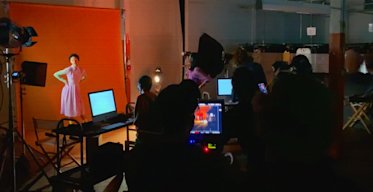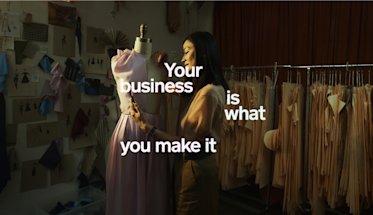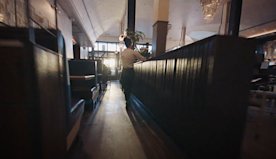The Shape of Things to Come is a global marketing campaign Square made over October 2020 to January 2021. It’s about what happens next. It’s about creating a sense of hope, reminding our audiences that in uncertainty there’s always potential and always a way forward. Throughout the process of building a global campaign remotely, we had to remind ourselves of some of those same things.
Like the entire creative community, we had to find new ways of navigating concepting and production to create something true to our vision. In the process, our script became something of a guide for us.
When you run a business you run with unknowns.
There were no shortages of unknowns when we kicked off in October 2020. How do we organize a working team across three time zones? How do we keep the set as safe as possible? How do we see what those on set are seeing?
What set us up for success was a practice of far-reaching collaboration. From the jump, we formed teams with people from all over Square to pitch campaign directions. People’s fresh ideas all factored in, galvanizing our concept, and ultimately making it more meaningful.
The team also had to consider those unknowns while keeping safety the top priority. Not only did we need to give creative direction, we also needed backups — backup crew, talent, wardrobe, locations, music, everything. We kept the crew small, made sure everyone was tested for COVID-19, and had the talent wear masks until it came time to shoot. Still, producers and project managers planned as though anything that could fall through would. And, in fact, we did end up using that backup wardrobe.
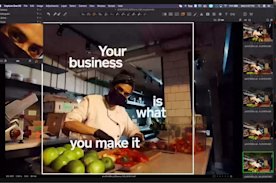
A glimpse through the camera, using copy overlays to compose the shot
With our creative mapped out and contingency plans in place, we were prepared. But that didn’t mean virtual production wouldn’t take some getting used to, or that we wouldn’t have to make some calls on the fly.
You run with split-second decisions and plans you make up along the way
No matter what, production is time-sensitive. You only have a certain amount of hours with crew and talent, you have to work with changing light, and you have to set up every shot perfectly. You can think of everything, but you still only have a few takes to nail it before you have to start setting up the next shot. Having the big picture helped us here — we just had to build it.
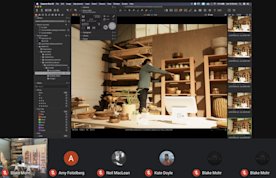
The production crew setting up a shot in our furniture factory set
When shooting for global audiences, too, the smallest details are critical. We had to be sure we were building a world that people in the UK, Australia, Canada, and the U.S. could see themselves in. In our restaurant, we set tables to portray each locale. We mirrored shots to put our car on the left side of the road. At our Los Angeles landscaping location, we were careful not to let palm trees steal shots. But while zeroing in, we had to keep an eye on how everything felt as a whole.
You run with false starts, fresh starts, and starts you never thought possible.
Sometimes a fresh look is just what you need. While creating our home office set, something we’ve long wanted to shoot properly, we were striking out with the home locations we scouted. What finally worked was a little side office in the furniture factory where we were shooting for another scene. With some hanging plants, some custom-made posters, desktops, and a cameo from Reece the dog, we made it a home. Seeing things from a new perspective saved us time and trouble. And, most importantly, it helped us get the shot.
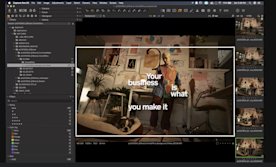
Composing the shot in our home office set
With the restrictions around shooting, we had to be sure what we were capturing would work perfectly later on. This required us to preplan every decision thoroughly to make a truly cohesive experience. Working with our digitech for both photo and video, we ended up using in-camera copy overlays to make sure shots were composed just how we needed them. Mapping out the copy, we were able to edit in real time, slightly changing a camera angle, rearranging posters in the background, or adjusting a pose.
When you run a business, you run a path only you create.
It took a lot of finessing every word, sound, and image throughout the process to make something that would stand out while remaining cohesive. When you have 30 seconds to tell a story — let alone three — every one of them is critical. To drive the energy, we used a forgotten anthem of the late 1960s. To texture our visuals, we used 16-mm film footage with mixed frame rates and strobe effects. We developed our type design to wrap our heroes, weaving messaging throughout, subtly reflecting the world around it.
Shooting in Covid has many challenges, but working through these challenges at a distance proved to be fairly easy to overcome due to the fact that our visions were so aligned.
Cait Oppermann, Photographer
Collaborating with director Terry Hall and video production partners Psyop, we experimented with exaggerated perspectives and stylized camera techniques to depict seeing things anew, approaching them from different angles — critical parts of these stories of pivoting and adapting. With photographer Cait Oppermann and photo production partners Versatile Studios, we cultivated a rich feel for our stories’ distinct colorways, designing lighting specifically to complement each palette. We wanted each detail to immerse the audiences further in these stories.
Experimenting with angle and lighting in our retailer shoot
And when you find what works, the future is yours to shape.
We knew that to realize our vision, we’d have to be as specific as possible for our production partners — we’d also have to truly trust whoever we brought on. Just like in concepting, we sought out partners who would push our work in ways we might not have thought of.
Another glimpse into the camera at our retailer shoot
In Hall and Oppermann and their teams, we struck gold. Hall brought deep experience in crafting 30-second spots and an eagerness to break conventions. Oppermann, with an incredible wealth of knowledge and talent, collaborated with us to elevate our photography while keeping it immediate and grounded in the realities of running a business.
Teams across the board — Photo, Video, Art Direction, Design, Copy, Project Management, Marketing — helped bring this campaign to life. Every idea factored in, and trust in the team helped forge something truly unique. Trust played a huge role in The Shape of Things to Come — from seeing possibility to working together in new ways. And in that way, these new challenges didn’t end up restricting us at all. They opened us up to new ideas, new solutions, and a creative execution we’re proud of.
Campaign credits: Justin Lomax (Creative Studio Lead), Ward Sorrick (Studio Lead), Kim Miles (Photography Lead), Carl Sturgess (Video Art Director), Evan Groll (Video Producer), Amy Schacter (Post Production Supervisor), Michelle Mintz (Photo Producer), Amy Feitelberg (Photo AD), Rob Dicaterino (Photo Post Producer), Ani Espejo (PD Producer), Eileen Tjan (Group Creative Director), Sean Conroy (Group Creative Director), Neil Maclean (Freelance Art Director), Said Fayad (Art Director), Kae Yen Wong (Senior Copywriter), Jonathan Skale (Senior Copywriter), Kate Doyle (Designer), Fin Wang (Designer), Alex Sirjani (Program Manager), Lauren Weinberg (Head of Global Marketing), Mandeep Gill (Global Brand Lead), Janjay Sherman (Brand Strategist), Tracy Kim (Associate Brand Manager), Jordan Ng (Brand Manager), Nat Meier (Social), Mallory Russell (Head of Content)
